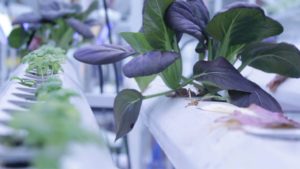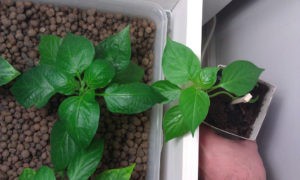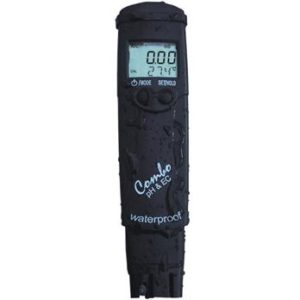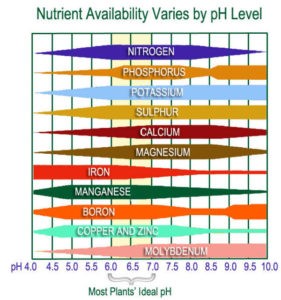
Hydroponics utilizes various methods of growing plants that does not require the use of soil. Instead, plants are grown in a nutritionally-neutral solution to which a nutrient-rich solution is added that provides the plants with everything they need to grow and flourish.
Advantages of Hydroponics
1. Plants can be grown using this method in areas where it is not otherwise possible for plants to grow such as areas where there is poor or rocky soil, or a limited amount of space. Hydroponics gardens can even be grown indoors when artificial lighting is included in the set up, allowing anyone to grow plants.
2. It is less labor-intensive as there is no need for preparing soil or weeding garden areas.
3. More plants are able to grow in a smaller area because every plant has full access to the nutrients. This then allows the gardener to maximize their gardening space.
4. Because the gardener has more control over the growing conditions and the nutrients their plants are receiving, they are able to provide more exactly for the needs of their plants which leads to healthier plants, higher quality produce, and larger yields.
5. Not only do plants grow more quickly and healthily in a hydroponics system, but they also tend to have a noticeably higher resistance to diseases and pests. Fruit and vegetable plants grown by this method will also have a better taste and texture than other plants.
Growing Medium
A neutral growing medium must provide specific things for the plant in order to be considered a viable medium. The growing medium in a hydroponics system must be:

– Physically supportive to the plant.
– Allows the nutrient solution and water to reach the plants’ root systems.
– Able to drain away excess moisture.
– Able to provide sufficient air circulation to the root system.
The most popular hydroponics growing mediums include:
– Screened-grade perlite.
– Vermiculite, which is often mixed with another medium for better water retention.
– Expanded clay.
– Rockwool.
– Coarse sand like washed river sand which is vastly different from beach sand.
– 1/8 inch to 3/8 inch (3 – 10 millimeter) gravel.
Nutrient Solutions
Without the proper nutrient solution, hydroponics simply does not work. There are a total of 13 nutrients that plants need to survive and grow. The proportion of these plants is also important. There are some major nutrients that are needed in much larger quantities and minor elements that only need to be present in small quantities. However, if even one of the minor nutrients is absent, most plants will not be able to perform as well.
Nutrient Film Technique

The nutrient film technique (NFT) was originally developed in England at what is called the “Glasshouse Crops Research Institute” by Dr. Allen Cooper. This method employs spreading a thin layer of nutrient-rich water on the bottom of several specifically-designed tubes or channels. The water then travels down to drain into a reservoir tank from which it is pumped back up to the top to circulate again. The plants are planted at the top of the channel. Their roots reach down to the layer of nutrient-rich water, but are not completely submerged so that they still have access to oxygen. The oxygenation process is also assisted by the splashing action that occurs when the water reaches the reservoir tank.
Advantages of the NFT System:
– Low initial investment when compared to other systems.
– Fast growth and turn-around.
– Increased control of the nutrients.
– No risk of plants drying out in between watering.
– Temperature can be controlled by changing warming or cooling the nutrient solution.
– Decrease in potential root infections since un-sterilized soil tends to have various pathogens.
– It conserves water.
Tips to Follow While Setting up a System:
1. Always check both the quantity and the quality of the water. You may need to have the water analyzed to check is nutrient levels and then make changes when needed. Different areas will have some variations in the nutrients already contained in the water.
2. Always make sure the channel is correct for the plant. It is vital that a plant be able to properly spread its roots, reach the water, and also grow unhindered without the root mass stopping up the system. Flat-bottom channels are best, and those with black plastics should be avoided if used outdoors because of how quickly the temperature can rise on a hot or sunny day.
3. The channels should have a slight gradient to encourage water flow. The gradient has to be straight and steady to keep the water from pooling.
4. Some of the things that affect the flow rate are the gradient and length of the channel and the flow and the pressure of the nutrient supply.
5. PVC and polythene pipes are commonly used for the drain and supply lines. Because the drain lines work because of gravity, it is important that they be sized properly and installed with the right amount of gradient for their length. Supply lines are pressurized using a water pump which means they don’t need to be sized as large as the drain lines which are not.
6. Be sure that the reservoir tank is twice as large as necessary as only approximately half of the volume should be enough to supply all of the plants with nutrients so that the tank can remain half-empty while being used. Also be mindful that the tank is made of non-toxic materials to prevent the leakage of harmful chemicals into the water supply.
7. The submersible pump should be able to maintain a flow of 0.5 to 1.0 liters per minute per channel, gully or tube. In order to keep the water level the same and to prevent burning the pump out be sure to check the reservoir tank routinely. If you need to be absent consider attaching a float valve to automatically adjust water levels while you’re away. For best results, choose a pump that can handle more water than what you’ll actually need.
8. Keep in mind that any components that are going to come into contact with the nutrient solution should be made of non-toxic materials such as stainless steel.
Testing Nutrient Solutions
To get the best possible results with hydroponics, focus on the quality of the nutrient solution. There are two main factors that determine the quality of a solution: the pH level and the nutrient strength. The good news is that there are simple tests to determine both of these factors.

PPM Testing
Parts per million is a way of measuring very minute amounts of diluted substances by using a ppm meter. In this case we’re measuring available amounts of nutrients in the water. Different plants have their own specific nutrient needs. For example, Tomatoes need on the upper end of the ppm range around 1400 ppm and Radishes around 950.
In Hydro, you can custom tailor the type of and amounts of nutrients the plants get and give it to them when they need it the most. Because of this, most professional growers dedicate each type of plant with it’s own system so as to give them a customized nutrient schedule. It’s okay though to mix a handful of different plants in the same hydro system if you’re doing a backyard hydroponic operation or otherwise a hobby grower…you will still get great results! Just remember, that if the nutrient schedule is too low the plants will starve, if it’s too high they will overload and die. A successful Hydroponicist always consistently checks and adjusts ppm levels.
pH Testing
pH stands for potential Hydrogen and it indicates how acidic or alkaline a particular solution is. The scale goes from 0 to 14. 7 is completely neutral, and pure water falls at this level. 0 – 6.9 is acidic and 7.1 – 14 is alkaline. The pH level is extremely important to growing plants both hydroponically and in soil because plants require a certain pH level to be present in order to absorb nutrients. Because the pH of each nutrient is slightly different, there is a very small range where all the nutrients can be absorbed properly.
The best pH range for plants is between 6.3 and 6.5, but plants will still do well between 6.0 and 7.0. Although plants can survive in the Ph level range of 5.0 and 7.5, it’s pertinent to aim for the optimum range for best results. If the pH level goes below 5.0, there will be too much acidity and could cause the root structures to be burnt and die. If the pH level goes above 7.0 and becomes too alkaline, many of the nutrients will become unavailable leading to the plant being unable to absorb them. Eventually killing the plant. pH levels need to be tested and adjusted routinely.
pH levels tend to naturally rise when plants use up various nutrients in the solution, which means the pH level have to be corrected by the addition of an acidic solution to lower the pH level. Always be careful when adding pH correcting solutions because adding them at full strength can shock the system and actually prevent the nutrients from being absorbed.
More Operating Tips:
1. Plants can be sprayed when needed, but don’t let too much of the spray drip into the draining system because toxic levels may become present in the nutrient system over time which will damage plants and can decrease yields.
2. Roots are sensitive to temperatures and should therefore be carefully maintained. Temperatures should be kept between a range of 47°F and 68°F (8°C and 20°C). In the winter, the nutrient solution may need to be heated to help maintain these temperatures. In the summer, be sure to avoid high temperatures.
3. When an automatic controller has been set up, the pH levels ought to still be checked by hand at least once per week. Additionally, the pH probe needs to be cleaned and buffered every week. The conductivity cell should also be regularly checked and cleaned to avoid false readings.
4. If plants show any signs of distress such as leaf discoloration, dying, or wilting, try changing the reservoir’s nutrient solution. The whole system will need to be flushed with pure water for a couple hours, and then the tank can be refilled and fresh nutrients added. On hot days, be careful about using extremely cold water because the temperature shock could damage plants further.
Whether seeking to grow plants for a family home or on a larger commercial basis, hydroponics is a great way for anyone to easily and effectively grow plants.

Leave a Reply
You must be logged in to post a comment.